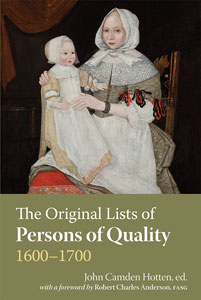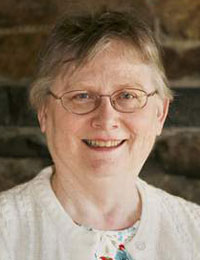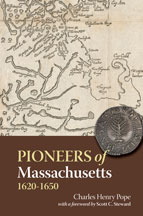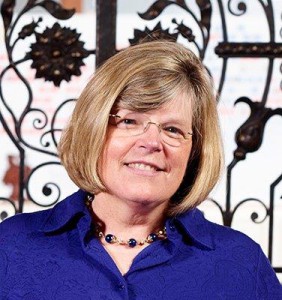 John Camden Hotten first published The Original Lists of Persons of Quality – his compilation of documents relating to seventeenth-century migration to New England, the Chesapeake, and the Caribbean – more than a century and a quarter ago, and it remains one of our most valuable and accurate sources for that period. He included in the volume the surviving records from the London Port Books, along with lists from some of the English outports. In addition, he included some muster rolls from Virginia, and other items listing early settlers there. Continue reading English port lists of the 1630s
John Camden Hotten first published The Original Lists of Persons of Quality – his compilation of documents relating to seventeenth-century migration to New England, the Chesapeake, and the Caribbean – more than a century and a quarter ago, and it remains one of our most valuable and accurate sources for that period. He included in the volume the surviving records from the London Port Books, along with lists from some of the English outports. In addition, he included some muster rolls from Virginia, and other items listing early settlers there. Continue reading English port lists of the 1630s
See you at RootsTech 2014
Next week brings the first big genealogical conference of 2014, with RootsTech in Salt Lake City from February 6–8. I’ll be there with some of my colleagues from NEHGS, and we hope to meet a number of you there!
We’ve been attending the conference since it started in 2011 and look forward to the chance it gives us to meet with members and other genealogists who are using technology to make family history easier and more engaging. There’s also something for every skill level, whether you are just starting to use your smartphone for research or you want to get involved in the conversation about the next GEDCOM standard. Continue reading See you at RootsTech 2014
Mourning rings as genealogical clues
 What to us might seem a rather morbid seventeenth-century tradition was the bestowal of mourning gifts on those who took part in your funeral, such as the coffin bearers, as well as family and friends. Samuel Sewall made a list of thirty funerals at which he was a “bearer” between 1697 and 1704, noting what he received for each service, which totaled twenty-four scarves, five pairs of gloves, and fourteen rings. (For the funeral of Thomas Broughton he got nothing.) By 1725, he had fifty-seven rings. Continue reading Mourning rings as genealogical clues
What to us might seem a rather morbid seventeenth-century tradition was the bestowal of mourning gifts on those who took part in your funeral, such as the coffin bearers, as well as family and friends. Samuel Sewall made a list of thirty funerals at which he was a “bearer” between 1697 and 1704, noting what he received for each service, which totaled twenty-four scarves, five pairs of gloves, and fourteen rings. (For the funeral of Thomas Broughton he got nothing.) By 1725, he had fifty-seven rings. Continue reading Mourning rings as genealogical clues
The Well-Stocked Genealogical Library
 To be complete, the well-stocked genealogical library should include general works on our research interests. Biographical dictionaries and other compendia are useful for looking at our ancestors’ contemporaries and their activities; they often provide clues for specific queries when the record in any one case is lacking, sending us off to an overlooked source or locality where the trail seemed cold. Continue reading The Well-Stocked Genealogical Library
To be complete, the well-stocked genealogical library should include general works on our research interests. Biographical dictionaries and other compendia are useful for looking at our ancestors’ contemporaries and their activities; they often provide clues for specific queries when the record in any one case is lacking, sending us off to an overlooked source or locality where the trail seemed cold. Continue reading The Well-Stocked Genealogical Library
NEHGS in Dublin
 As the NEHGS Director of Education, it’s part of my job to plan and coordinate our research tours and programs across the country and beyond the U.S. In past years, we have offered research trips to such places as Washington, D.C., Salt Lake City, London, Belfast, and Montreal, among others. Continue reading NEHGS in Dublin
As the NEHGS Director of Education, it’s part of my job to plan and coordinate our research tours and programs across the country and beyond the U.S. In past years, we have offered research trips to such places as Washington, D.C., Salt Lake City, London, Belfast, and Montreal, among others. Continue reading NEHGS in Dublin
Beasts, Bees, and Indian Corn
 Probate inventories can tell us a lot about the living conditions of our ancestors, but as they are usually difficult to read and interpret, more often than not the little details are skipped by family historians. Nearly everyone records the amount of land in the inventory, but that rarely tells us much about how good the land was, nor how good the farmer was. Because I’m an old aggie student (University of Connecticut 1969), I like to look at the inventories of livestock and crops to learn more about the farms and their owners. Continue reading Beasts, Bees, and Indian Corn
Probate inventories can tell us a lot about the living conditions of our ancestors, but as they are usually difficult to read and interpret, more often than not the little details are skipped by family historians. Nearly everyone records the amount of land in the inventory, but that rarely tells us much about how good the land was, nor how good the farmer was. Because I’m an old aggie student (University of Connecticut 1969), I like to look at the inventories of livestock and crops to learn more about the farms and their owners. Continue reading Beasts, Bees, and Indian Corn
U.S. Veteran memorials
For many years one of my personal projects has been to mark the graves of ancestors without gravestones. In the case of ancestors who were honorably discharged from the United States military, I honor their memory by adding an inscription relating to their service. If this idea seems appealing to you, you may wish to know that the United States government will assist in creating and will often pay the costs to erect a standard upright or flat marker for military veterans’ graves. Continue reading U.S. Veteran memorials
What you know (and can prove)
 “Write down what you know” is the first step in family history research. For many of us, what we know includes family stories that have been passed down from generation to generation. But sometimes those stories can be misleading – or just plain incorrect. For example, my stepmother had always heard that she was related to Ralph Waldo Emerson and General William Tecumseh Sherman. I have a set of notes written by her aunt, Minerva McGee (1897-1972), which begin like this:
“Write down what you know” is the first step in family history research. For many of us, what we know includes family stories that have been passed down from generation to generation. But sometimes those stories can be misleading – or just plain incorrect. For example, my stepmother had always heard that she was related to Ralph Waldo Emerson and General William Tecumseh Sherman. I have a set of notes written by her aunt, Minerva McGee (1897-1972), which begin like this:
General Sherman — younger brother of Catherine Sherman
Ralph Waldo Emerson — younger brother of John Emerson
John Emerson — Catherine Sherman, My Great Grandparents.
Unfortunately, Aunt Minerva was wrong. Continue reading What you know (and can prove)
Speaking in public
The first month or so of the New Year is turning out to be quite a busy one in terms of presenting lectures. Part 1 of a Mobile Genealogist series on Dropbox and Evernote is done, part 2 of the series on the Flip-Pal scanner and cameras is upcoming on February 1, and I will be off to Salt Lake City to present on Evernote at RootsTech the week after. Under development is a lecture for the Fundamentals track of the 2014 Massachusetts Genealogical Council (MGC) Annual Meeting and Seminar on July 26 in Mansfield, Massachusetts. Continue reading Speaking in public
Social media for genealogists
 At the moment, I am working on three different family histories, two of them for families in Boston, and one for a New York Dutch clan.
At the moment, I am working on three different family histories, two of them for families in Boston, and one for a New York Dutch clan.
As part of the research process, each of these family histories will, at some point, generate a questionnaire for modern-day family members. With each book project, the question arises: How best to encourage family members to fill out yet another form, in this case running to several pages? Continue reading Social media for genealogists